Seiko
· 
Kintarō Hattori (1860-1934) founded the present-day Seiko watch company in 1881.
· 
In 1913, Seiko produced the first wristwatch in Japan under the name Laurel.
· 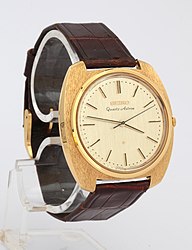
Seiko invented the world's first quartz wristwatch, the Quartz Astron, in 1969.
·
Pogue Seiko, today's auction value ca. 1.000 €
· 
· 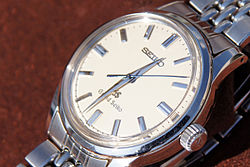
Grand Seiko SBGW005
· 
Elvis Presley with a Seiko LCD Alarm Chronograph (1972)
· 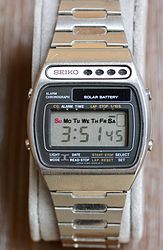
The Seiko LCD Solar Alarm Chronograph A156-5000 was 1978, the world's first solar-powered wristwatch.
· 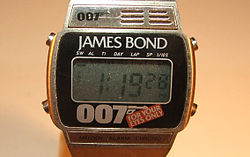
In the 1981 feature film In Deadly Mission, James Bond made a phone call via satellite with this LCD Seiko.
· 
The SKX007 was Seiko's longest-produced wristwatch at 23 years, from 1996 to 2019.
· 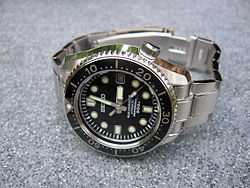
The SBDX001 Marinemaster was the first Seiko with a monocoque case.
Seiko (officially Seikō Holdings K.K.) is an independent watchmaking group headquartered in Tokyo, Japan. The company completely dispenses with subcontractors and produces all components, raw materials, operating materials and auxiliary materials 100% itself. This type of watch production is unique in the world. Seiko is solely owned by the Hattori family.
Company History
Company foundation (1881)
In 1881, Kintarō Hattori (1860-1934) founded a watch repair business in what is now the Ginza district of Tokyo. At that time, he still traded under the name Hattori Tokeiten (Engl. "Hattori watchmaker's store"). In 1892, Hattori additionally acquired a disused factory building in Tokyo's Sumida district and established a watch factory there under the name Seikōsha with the aim of producing Japan's best wall clocks. Seikōsha is an acronym standing for Seikō (meaning precision) and Sha (meaning house), meaning precision house. The successful sales of wall clocks encouraged Hattori to expand his company's product line. In 1895, he designed a pocket watch called the Timekeeper. By the early 1900s, Seikōsha was the largest manufacturer of pocket watches, alarm clocks and wall clocks in Japan at the time.
Japan's first wristwatch (1913)
The first wristwatch produced 100% in Japan was a product of the Seikōsha Company and was manufactured under the name Laurel in 1913. In 1923, the Great Kantō Earthquake destroyed the headquarters in Ginza and the Seikōsha factory in Sumida. Kintarō Hattori invested all his private wealth and completely rebuilt the company.
Seiko as a brand name is introduced (1924)
In 1924, the first wristwatch with the SEIKO imprint on the dial was produced. In the same year, the SEIKO brand name was also patented. In 1929, the Japanese National Railway appointed Seiko as the official supplier for railroad timekeeping.
Technology innovations
In 1955, Seiko introduced its first automatic wristwatch. A year later, in 1956, Seiko released the shock protection Diashock. In 1959, Seiko developed the Magic Lever. At the time, the Magic Lever was a new type of component for the winding mechanism. By using the oscillating weight, regardless of the direction of rotation, it increased the efficiency of the automatic winding mechanism. This component is directly attached to the shaft of the flywheel mass, ensuring a more efficient elevator. In 1963, the Swiss Observatory Cantonal in Neuchâtel allowed Seiko to participate in watch competitions. Seiko achieved a second and a third place. Seiko sent caliber 45 movements to Neuchâtel, which were later further developed for Grand Seiko brand watches. These watches were then marketed as specially calibrated timepieces. In 1965, Seiko introduced the first mechanical diving watch from Japan, the 62MAS. In 1966, the 62MAS proved its reliability during the 8th Japanese research expedition in Antarctica. At that time, this diving watch had a water resistance of 150 meters. In 1967, Seiko's first automatic wristwatch gained notoriety and won several awards.
The world's first quartz watch (1969)
In the 1960s, Seiko was in a race with the Swiss watch company Rolex to produce the world's first quartz wristwatch. The Japanese won the race and presented the world's first quartz wristwatch ready for series production, the Seiko Quartz-Astron, to the global public in December 1969, while Rolex was not able to present a quartz watch of its own production until April 1970. The tuning fork quartz oscillator invented by Seiko had a frequency of 8,192 oscillations per second (Hz), resulting in a rate deviation of only five seconds per day. The Quartz Astron was produced in a limited edition of 100 pieces and cost 450,000 yen (about 7,600 German marks), which was about the price of a Toyota Corolla at the time. A Seiko automatic chronograph, with a yellow dial, was worn by William Pogue in space during the Skylab 4 mission between 1973 and 1974. It is thus the first automatic chronograph to be worn in space. It became world famous under the name Pogue Seiko.
Grand Seiko since 1960
In 1960, Seiko introduced the Grand Seiko luxury brand. The first Grand Seiko had a balance frequency of 2.5 hertz and a precision of +12 to -3 seconds per day with a power reserve of 45 hours. At that time, the model in the gold-plated case cost 25,000 yen, which was equivalent to four times the monthly salary of an office worker in Tokyo. The design of the model was simple, and on the dial was the inscription Chronometer.
To date, caliber testing of Grand Seiko watches is much more extensive and time-consuming than that of Swiss competitors. The technical movement testing includes more layers, more temperature ranges, and more days than the normal chronometer testing performed by the independent Swiss inspection body COSC. Seiko calls these tests the Grand Seiko Inspection Standard. All Grand Seiko calibers begin with the same number, 9. According to Seiko, this numerically highest number represents the pursuit of the perfect watch. A lion emblem, as a symbol of the brand, adorns the case back of each Grand Seiko as an engraving. The watches are offered in the upper price segment starting at €2,000. Grand Seiko wristwatches have been officially available in Germany since 2010.
Invention of the Spring Drive technology (1999)
With the Spring-Drive-Technology, which was launched in 1999, Seiko introduced the rate accuracy of quartz watches in mechanical watches. Spring-Drive technology is based on the fact that the last wheel of the movement, which corresponds to the escapement wheel, on the one hand supplies a quartz movement with energy and on the other hand is kept at a constant speed by the quartz movement ("Tri-Synchro-Regulation System"). As a result, the spring-drive movement moves continuously, and the second hand glides across the dial without ticking. Spring-Drive movements guarantee a rate accuracy of only one second deviation per day.
The power reserve in Seiko's Spring Drive movements is at least 72 hours. These movements are only offered by Seiko for wristwatches in the upper price segment.
Company headquarters
The Seiko Group has its official registered office in the Tokyo district of Chūō, in the Ginza district. The company has been listed on the Tokyo Stock Exchange since 1949 and, as the holding parent company under the name Seikō Holdings K.K., is responsible for the subsidiaries Seikō Watch, Seikō Clock, Seikō Precision and Seikō Optical Products. President of Seikō Holdings K.K. since April 30, 2010 is Shinji Hattori, a great-grandson of Kintarō Hattori.
Seiko Germany has its headquarters in Willich.
Product placements for James Bond
- Between 1977 and 1983, Seiko was the official watch supplier for the James Bond films starring Roger Moore. As early as 1973, Moore wore a Pulsar P2 2900 LED in the film Live and Let Die. Pulsar is now a Seiko subsidiary.
- The Spy Who Loved Me (Seiko 0674 LC)
- Moonraker - Top Secret (Seiko M354)
- On a deadly mission (Seiko H357 5040)
- Octopussy (Seiko G757 and Seiko TV-Watch DXA001/002)
Developments since 1881
- 1881 Kintarō Hattori (1860-1934) established a watch repair business in Tokyo.
- 1892 Kintarō Hattori opened a factory under the name Seikōsha and produced his own wall clocks and alarm clocks.
- 1895 Seikōsha produces pocket watches for the first time under the name Timekeeper.
- 1913 The first Japanese wristwatch was produced by Seikōsha under the name Laurel.
- 1924 Seikōsha introduced Seiko as a brand name, and for the first time the Seiko name is printed on a dial.
- In 1929, Seiko became the official supplier for the Japanese National Railway.
- 1956 Seiko introduced the shock protection Diashock.
- 1959 The Magic Lever (self-winding) was first introduced in the Seiko Gyro Marvel.
- In 1965, Seiko produced the 62MAS, the first mechanical diving watch from Japan.
- 1969 The world's first quartz wristwatch Seiko Quartz Astron was introduced.
- 1972 Introduction of the world's first LCD quartz clock with six-digit digital display.
- 1975 The world's first diver's watch with titanium case components was introduced.
- 1976 Introduction of the world's first quartz printer.
- 1978 Introduction of the PYF18, the world's first diver's watch with quartz movement.
- 1982 Introduction of the world's first hybrid dive watch, the SAD017, with bilingual display for underwater communication.
- 1983 The world's first TV watch, caliber DXV002 with screen, is introduced.
- 1984 Introduction of the world's first wristwatch with computer functions.
- 1990 Introduction of the world's first computerized diving watch "Scubamaster SBBK001".
- 1996 Launched the SKX007 mechanical diving watch. It was Seiko's longest produced wristwatch. The production was stopped only in 2019.
- 1998 Launch of Seiko Thermic, first wristwatch powered by ultrasonic microrotor.
- 1999 Introduction of the world's first Spring Drive watch.
- 2000 Introduction of the SBDX001 Marinemaster.
- 2005 Introduction of the world's first three-band radio-controlled clock.
- 2006 The world's first watch with electrophoretic display (EPD) was introduced.
- 2010 The world's first EPD watch with active matrix system was introduced.
- 2012 The first watch with a built-in GPS receiver was presented at Baselworld 2012.
Search within the encyclopedia
